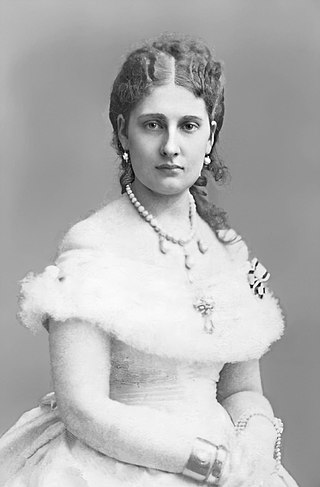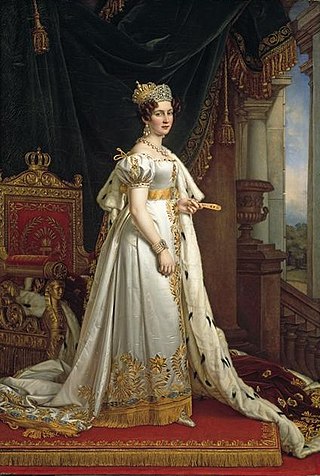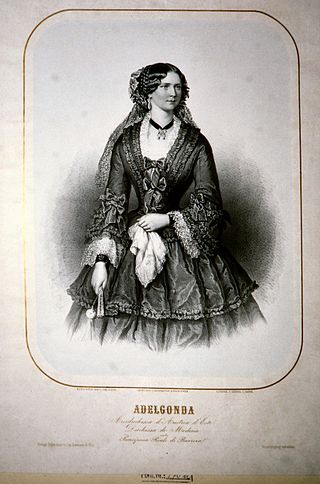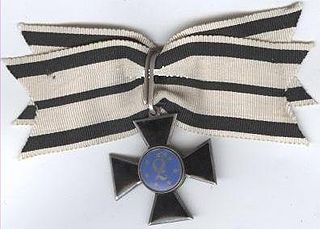History
The order was founded on 12 December 1827 by Queen Therese of Bavaria, wife of King Ludwig I of Bavaria. [1] She established an endowment which paid an annual pension to twelve unmarried noble ladies, six of whom received 300 guilders and six of whom received 100 guilders. The pension ceased when a member married; if, however, the marriage was according to the rank of the member, then the lady was permitted to continue to wear the insignia of the order and be known as an Ehrendame (Lady of Honour).
Various other ladies also held the rank of Ehrendame including all the princesses of the House of Wittelsbach. Bavarian ladies paid a reception fee of 55 guilders while foreign ladies paid 220 guilders.
The insignia of the order is worn on the left breast and consists of a blue-enameled Maltese cross with a wide white edge, over which is placed a gold royal crown. [1] In the four angles of the cross are lozenges with the blue-and-white arms of Bavaria. At the centre of the cross is a gold bordered white circular medallion decorated with the letter T. On the back of the medallion is the year 1827 and the motto of the order “Unser Leben sey Glaube an das Ewige” (Our life is Faith in Eternity).
The ribbon of the order is white with two sky-blue stripes at the edge, the inner stripe being narrower than the outer stripe. The sash of the order is a similarly coloured broad ribbon, worn diagonally from the right shoulder to the left hip.
Among the current Ladies of Honour of the order is the Hereditary Princess of Liechtenstein.

The House of Leszczyński was a prominent Polish noble family. They were magnates in the Polish–Lithuanian Commonwealth and later became royal family of Poland.

Louis IX of Hesse-Darmstadt was the reigning Landgrave of Hesse-Darmstadt from 1768 to 1790.
Duke in Bavaria was a title used among others since 1506, when primogeniture was established, by all members of the House of Wittelsbach, with the exception of the Duke of Bavaria which began to be a unique position. So reads for instance the full title of the late 16th century's Charles I, Count Palatine of Zweibrücken-Birkenfeld and patriarch of the House of Palatinate-Birkenfeld: "Count Palatine by Rhine, Duke in Bavaria, Count to Veldenz and Sponheim". The title grew in importance as Wilhelm, Count Palatine of Zweibrücken-Birkenfeld-Gelnhausen began to use it, in the early 19th century, as his primary title – Duke Wilhelm in Bavaria. This choice has also had effect for his descendants.

Infanta Antónia of Portugal was a Portuguese infanta (princess) of the House of Braganza, daughter of Queen Maria II of Portugal and her King consort Ferdinand II of Portugal. Through her father, she also held the titles of Princess of Saxe-Coburg and Gotha and Duchess of Saxony.

Prince Ludwig Ferdinand Maria Karl Heinrich Adalbert Franz Philipp Andreas Konstantin of Bavaria was a member of the Bavarian House of Wittelsbach and a General of Cavalry. Following his marriage to Infanta María de la Paz of Spain, he was also created an Infante of Spain.

Infanta María de la Paz of Spain was a Spanish infanta. A daughter of Queen Isabella II, she married her cousin Prince Ludwig Ferdinand of Bavaria. She lived the rest of her life in Germany, dedicating her time to her family, charity work and writing poetry. She wrote a book of memoirs: Through Four Revolutions: 1862–1933.

Therese Charlotte Luise of Saxony-Hildburghausen was queen of Bavaria as the wife of King Ludwig I.

The Order of Queen Saint Isabel is a Roman Catholic dynastic order of which the Grand Mistress is the Duchess of Braganza.

Karl-Theodor, Duke in Bavaria, was a member of the House of Wittelsbach and a professional oculist. He was the favorite brother of the Empress Elisabeth of Austria, and father of Queen Elisabeth of the Belgians.

Prince Adalbert Wilhelm Georg Ludwig of Bavaria was the ninth child and fourth son of Ludwig I of Bavaria and Therese of Saxe-Hildburghausen.

Princess Adelgunde of Bavaria was a daughter of Ludwig I of Bavaria and Therese of Saxe-Hildburghausen. She was Duchess of Modena by her marriage to Francis V, Duke of Modena.

Prince Alfons of Bavaria was a member of the Bavarian Royal House of Wittelsbach and a General of Cavalry.

Franz, Prince of Bavaria was a member of the Bavarian Royal House of Wittelsbach and a Major General in the Bavarian Army.

The Order of Louise was founded on 3 August 1814 by Frederick William III of Prussia to honor his late wife, the much beloved Queen Louise. This order was chivalric in nature, but was intended strictly for women whose service to Prussia was worthy of such high national recognition. Its dame companion members were limited to 100 in number, and were intended to be drawn from all classes.

Duchess Charlotte Georgine of Mecklenburg-Strelitz was a member of the House of Mecklenburg-Strelitz and a Duchess of Mecklenburg-Strelitz by birth and a Duchess of Saxe-Hildburghausen through her marriage to Frederick, Duke of Saxe-Hildburghausen.

Princess Isabella of Bavaria was the third child and eldest daughter of Prince Adalbert of Bavaria and his wife Infanta Amalia of Spain. By her marriage to Prince Tommaso, Duke of Genoa, she became referred to as the Duchess of Genoa.

Duke Siegfried in Bavaria, full German name: Siegfried August Maximilian Maria, Herzog in Bayern (10 July 1876, Bamberg, Kingdom of Bavaria – 12 March 1952, Munich, Republik of Bavaria) was a Duke in Bavaria and member of the House of Wittelsbach. Siegfried August was the first of three sons of Duke Maximilian Emanuel in Bavaria and his wife Princess Amalie of Saxe-Coburg and Gotha. Siegfried August was the brother of Christoph Joseph Clemens Maria, Duke in Bavaria and Luitpold Emanuel Ludwig Maria, Duke in Bavaria.

The royal descendants of John William Friso, Prince of Orange currently occupy all the hereditary European royal thrones. Friso and his wife, Landgravine Marie Louise of Hesse-Kassel, are the most recent common ancestors of all European monarchs, current and former, that have reigned since World War II. Louis IX, Landgrave of Hesse-Darmstadt and his wife, Countess Palatine Caroline of Zweibrücken, are the most recent common ancestors of all current European monarchs, but not all of the living and deceased monarchs since World War II.

Duchess Sophie in Bavaria.
This page is based on this
Wikipedia article Text is available under the
CC BY-SA 4.0 license; additional terms may apply.
Images, videos and audio are available under their respective licenses.



















